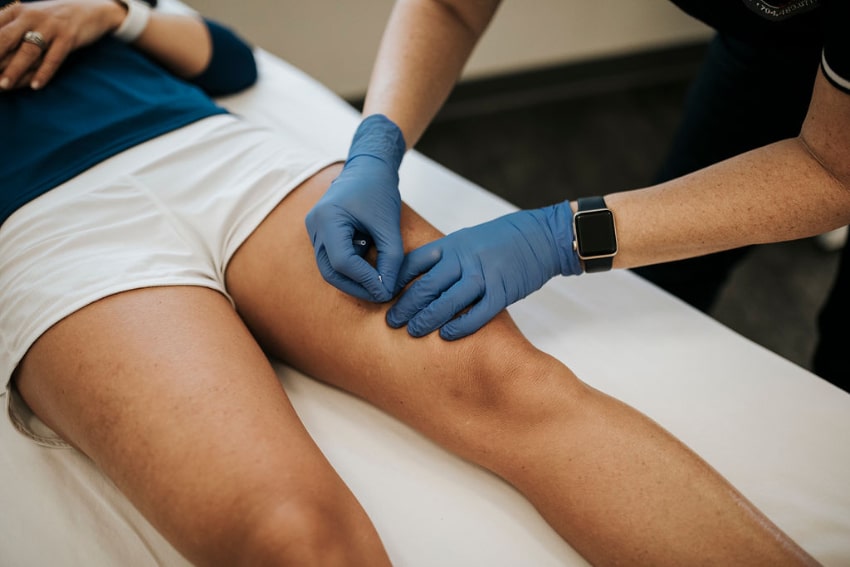Trigger Point Dry Needling (TDN) is a treatment technique that utilizes thin, solid filament needles to deactivate and desensitize trigger points in muscles. Myofascial trigger points are knots in muscles that can contribute to pain, decreased flexibility and decreased muscle function. TDN is an effective and efficient method of releasing trigger points, especially when other manual soft tissue techniques are unable to directly release or release as many trigger points. TDN is also known as Intramuscular Manual Therapy (IMT). Phoenix Physical Therapy and Wellness Specialists is one of very few clinics in the United States that has a certified therapist on staff to perform this revolutionary treatment.
The only similarity to acupuncture is the use of a thin, solid filament needle. Traditional Acupuncture aims to promote health and restore “energetic balance” by stimulating certain acupuncture points found along certain meridians throughout the body. It is one aspect off a Traditional Chinese Medicine approach which includes diagnosis and clinical reasoning using various Chinese medicine assessment methods. Western or Medical Acupuncture also aims to stimulate acupuncture points along meridians, but applies it to western medical reasoning utilizing anatomy and neurophysiology as its basis and not traditional Chinese medicine. TDN is based on anatomy and neurophysiology and its aim is to needle altered or dysfunctional tissues in order to improve or restore function, in most cases specifically myofascial trigger points.
The exact mechanisms of TDN are not known. Dr. Janet Travell first described trigger point injections in the early 1940s. Injections are performed by injecting trigger points primarily with analgesics. Over the years it has been shown that it is not the substance that is being injected that is providing the long-term therapeutic benefit, but rather the mechanical stimulus of the needle itself. When a needle tip hits a trigger point, a characteristic ‘local twitch’ in the muscle is noted by the clinician and the client. This local twitch is involuntary. It has been shown that the elicitation of local twitch responses is the most important aspect in obtaining a successful therapeutic outcome for trigger point deactivation. There are a number of hypotheses as to the reasons why dry needling works. Dry needling and the subsequent local twitch responses may mechanically disrupt the contracted nature of the trigger point. Dry needling stimulates certain neurological sensors in the body which modulate pain signals. Dry needling and the subsequent local twitch responses can cause positive local biochemical changes and result in an increase of blood flow.
Muscle dysfunction can be the primary or secondary contributing factor to many neuromusculoskeletal conditions. Such conditions would include repetitive stress injuries, muscle tendonitis, neck pain, headaches, rotator cuff impingement, frozen shoulder, carpal tunnel syndrome, sacroiliac joint dysfunction, sciatica, muscle strains, iliotibial band syndrome, patellofemoral dysfunction, and plantar fasciitis. If active trigger points are found to be causing pain, muscle tightness and/or muscle weakness then they would benefit from being treated by TDN.
Most people do not feel the insertion of the needle. The local twitch response elicits avery brief cramping and/or deep aching sensation. TDN may reproduce symptoms directly in the muscle being treated or may refer to other areas of the body. This is a form of referred pain, which is one of the hallmarks of trigger points. Elicitation of local twitch responses and recognizable referred pain is a good and desirable reaction because it confirms a possible source of dysfunction.
Yes, we only use the highest quality sterile, disposable needles.
In some cases, decreased pain and improved mobility is immediate. Typically, it may take a few treatment sessions for a lasting positive effect. Again we are trying to cause mechanical, biochemical and neurological changes without any pharmacological means. Therefore, we are looking for a cumulative response to deactivate trigger points, disrupt pain and to restore optimal muscle function.
It is typical to experience soreness in the area treated for 1-2 days. The soreness is quite tolerable for most and is easily alleviated with cold/heat and stretching.
In the United States, TDN is a relatively new method for treating myofascial trigger points and not everyone is already aware of this effective treatment modality. Needling therapies are very common practice for physiotherapists in Canada, Australia, New Zealand, Europe, and South Africa and is slowly making its way through the United States. More and more physical therapists are incorporating TDN into their practice. Incorporating the treatment technique with other manual and rehabilitative methods is showing to be very effective in treating various neuromusculoskeletal conditions. Feel free to inform your doctor about this treatment option. It is upon all of us to educate others about new and innovative ways to treat pain.
Speak with one of our therapists or schedule an appointment to determine if TDN would be an appropriate for your injury or condition.


